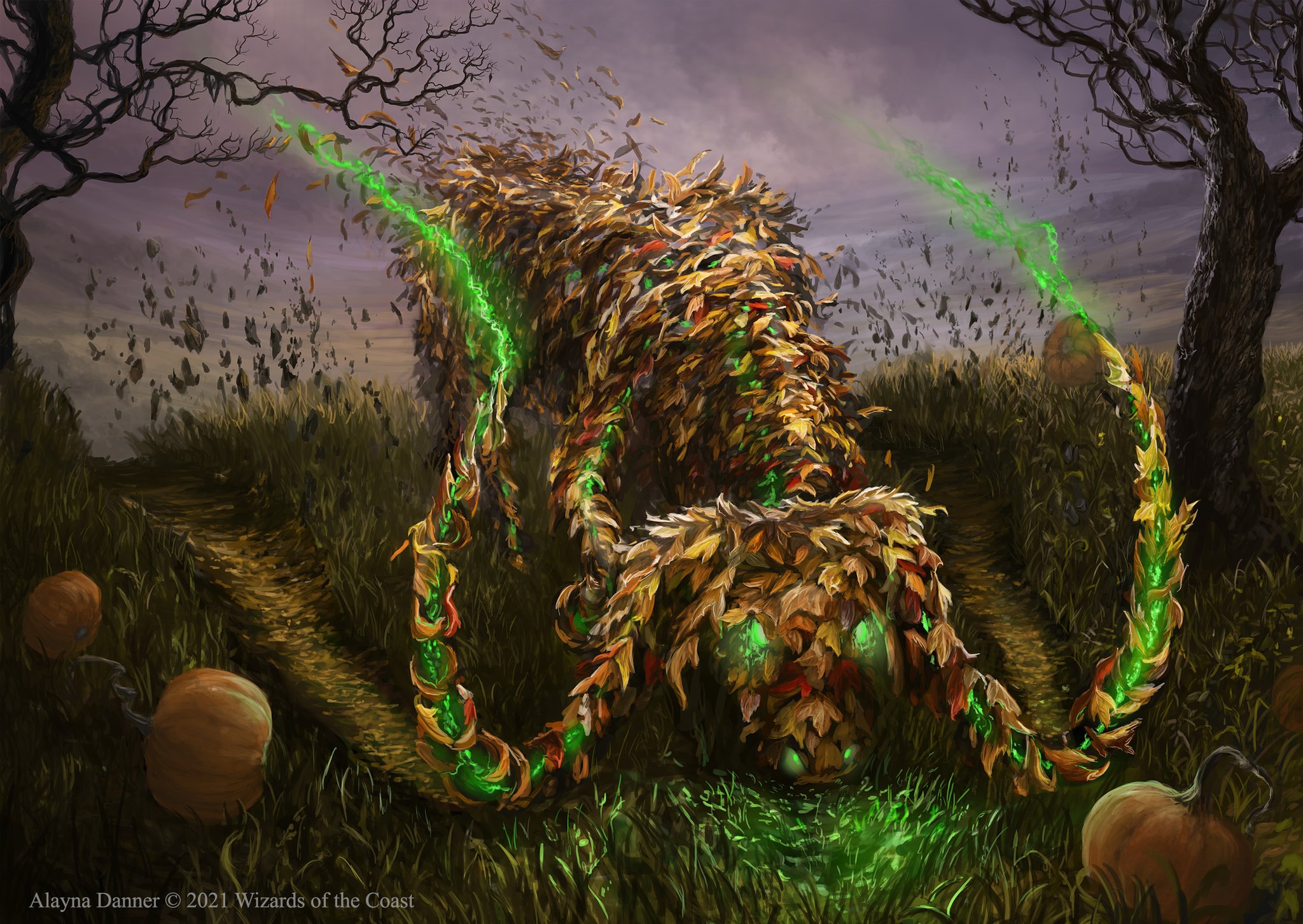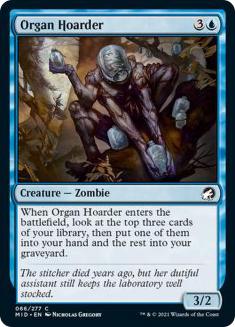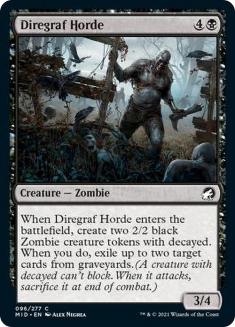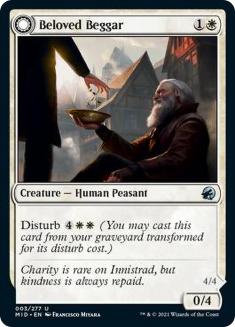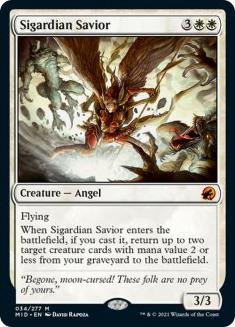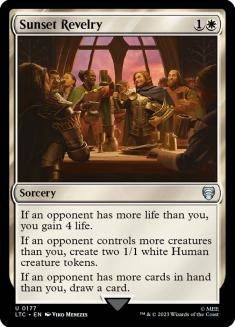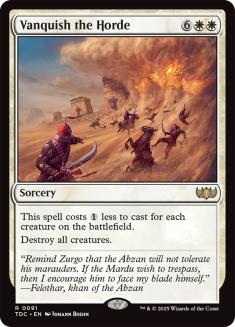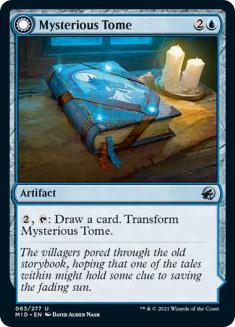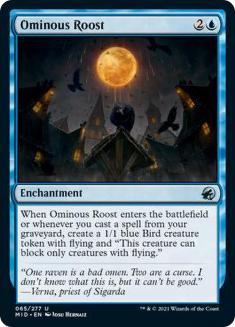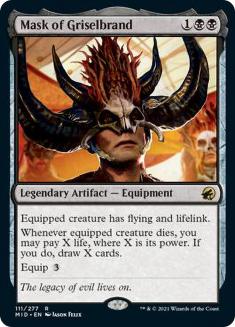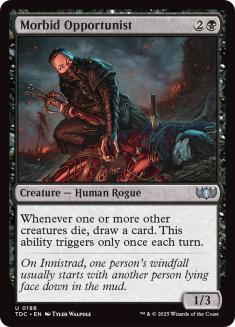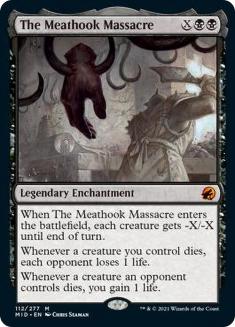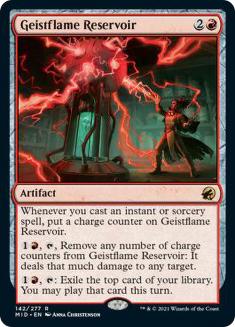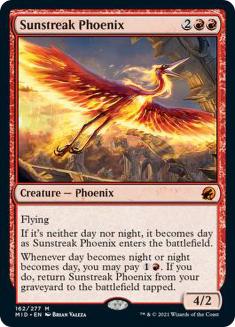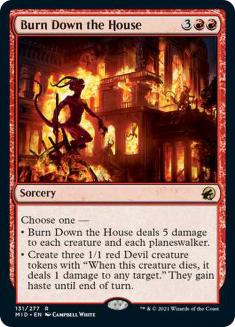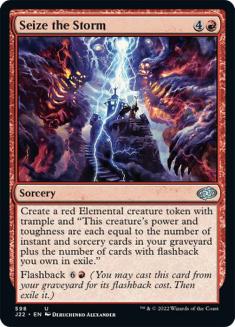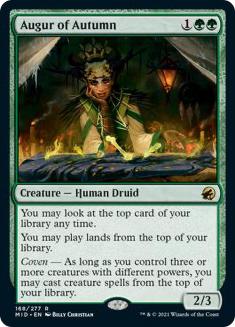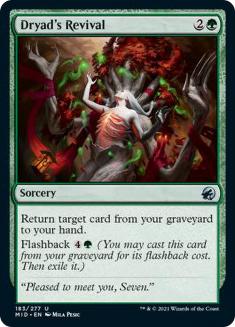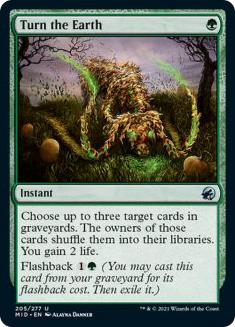In a format like Innistrad: Midnight Hunt Limited, I expect most players to have pretty strong archetype preferences. Specifically, I expect most players who have been studying the format to have a preference to end up in Dimir, with openness to substituting white for either blue or black, and possibly having some other archetype(s) they feel comfortable drafting. Even if you don’t think of yourself as having a preference for these archetypes, and just try to draft the best cards, more often than not you’ll end up in these decks because most of the good cards happen to lead that way.
However, sometimes you’ll see a particularly powerful card in another color. Do you take it or steer clear? If you take it, what do you do next? Moreover, some powerful cards are only good in certain kinds of decks. Do you know how to make them work on the fly?
If your deck is built around commons, it probably does relatively normal things. Commons appear in packs more often, so more decks are built around them — they define what normal is. Also, cards that point toward more narrow or divergent strategies tend to primarily get printed at higher rarities. What this means is that when you’re drafting around commons, most normal wisdom about the format applies. This could be stats on 17Lands.com, your previous experience with cards, or any tips you’ve picked up from other people. All the general wisdom will primarily refer to the way the commons in a format play.
When a deck is built around one or more rares or particularly narrow uncommons, it can find itself trying to do different things from what decks of its color normally do. The more divergent your strategy is from what’s normally done with commons, the more you can and should ignore conventional wisdom when evaluating which cards you want for your deck.
When drafting Selesyna Aggro around coven, I can expect that most other Selesnya drafters have had very similar decks to me, so if I’m trying to decide between two cards, I can see which has typically performed better in Selesnya decks on 17Lands.com; if one card has an appreciably higher win rate, I can expect that it will likely perform better in my deck.
If I first-picked Wrenn and Seven and then got passed Vanquish the Horde and decided to draft Selesnya Control, I’m going to ignore how well commons typically perform in Selesnya decks because my deck isn’t going to look like most Selesnya decks. Maybe I’ll try to build a deck around Eccentric Farmer to mill myself with Dryad’s Revival to find or reuse my bombs; maybe I’ll look to fill it out with white disturb creatures to play well with Vanquish the Horde and Eccentric Farmer. In such a deck, Beloved Beggar might perform quite a bit better than it typically does in Selensya decks. I would also be more likely than usual to prioritize Candletrap, since attacking is going to be less important to me and I’ll want to slow the game down.
Dryad’s Revival would be an important part of that deck. It’s uncommon, so I can’t count on seeing it, though it’s typically drafted fairly late, so my chances aren’t bad. Yet to end up in the deck I described, I’d probably need to see one early in the draft to know that that’s something I can do. That’s a pretty specific circumstance, right? Well, yes, but that’s entirely the point. These outlier drafts only happen when things line up in a certain very unlikely way. This makes it hard to talk about how do draft these decks; you can’t just decide to do it, it just falls in your lap, but you have to know how to be open to it.
The most important skill for drafting a deck like this is mastery of the fundamentals so that you know how to craft a deck on the fly, because it will often be something you hadn’t really considered until it’s happening, and you’ll need to be able to figure out what this new creation you find yourself with needs. That’s hard to spell out in a single article though, so instead I want to take a stab at going over the niche cards in Innistrad: Midnight Hunt and what you might need to look for to take advantage of them if you find yourself in the right spot.
White
If your deck is extremely defensive, you can maybe use Beloved Beggar with the goal of blocking, but for the most part, this is a payoff for milling yourself, discarding cards, or sacrificing creatures. This isn’t really a traditional build-around, but it’ll vary widely in power level depending on the cards you pair it with.
A five-mana 3/3 flyer is nothing special, but a five-mana 3/3 flyer that adds two other creatures to the battlefield is exceptional. If you play a normal deck with some two-mana creatures in it, in some matchups you can expect those creatures to naturally end up in your graveyard and in some you can’t. If you pick up a Sigardian Savior early, you want to try to end up in an archetype with some sacrifice outlets, self-mill, or at the very least cheap creatures with more power than toughness so that they’re likely to trade in combat.
Most white decks in this format are looking to curve out and stay ahead on the battlefield. Coven pushes you to play a lot of cheap creatures, and Sunset Revelry plays badly with that strategy. If you’re likely to be playing from the back foot, Sunset Revelry has a lot of potential. Like Beloved Beggar, it isn’t a card you’re going to build your deck around, but if you find yourself trying to build an usually controlling white deck, these could both have a place.
White often has the issue in Limited that for the most part, the color wants to be aggressive and has very little card advantage that doesn’t rely on putting creatures on the battlefield, which makes the rare sweeper awkward to try to use. Disturb helps that, and so does anything else than can fill your hand or spend your mana in a way that doesn’t play creatures into your own sweeper more than necessary. You’ll ideally want to find things to spend your mana on that disguise the fact that you’re building up to a sweeper. Typically, this plays best with blue for ways to draw cards.
Blue
For the most part, Mysterious Tome has felt too slow for this format, but you can always draft to slow things down further to try to create games that are slow enough that you can take advantage of such a card. Removal and good defensive creatures are great ways to slow the game down, but the most important part of building around Mysterious Tome is making sure that the rest of your curve is low so that you have the mana free to activate it every turn.
For the most part, Ominous Roost is a card for Azorius Spirits decks, but it can potentially have use in Simic Graveyard / Flashback decks. Aside from the fact that you need to make sure you have enough ways to trigger this, the biggest issue with this card is that the Birds can only block flyers, which means this card doesn’t play good defense. If you’re trying to use it, you need to make sure you have other cards that will stop you from getting run over while your Birds attack your opponent. Look for cards that you can cast out of your graveyard, obviously, but very strongly prioritize those that can be cast more cheaply. Also look for cards that mill you. This is one of the best reasons to use Otherworldy Gaze.
You’re also looking for things that keep you alive. Larder Zombie and Skaab Wrangler are both fantastic here, as Larder Zombie blocks and can use your Birds to find more fuel and Skaab Wrangler allows you to use Birds defensively.
Black
Black cards are tricky to talk about in this context in this format because black as a color is so powerful and flexible. Vengeful Strangler wants you to be aggressive and to have ways to sacrifice it, which means that it plays well in some decks and not in others, but it’s not asking you to do anything particularly unexpected for black.
Mask of Griselbrand wants you to have a good density of creatures that are impactful enough to equip but cheap enough that you won’t lose the game if your opponent kills one in response to equipping it, and mostly just wants you to make sure you can keep the game going long enough for it to take over.
Morbid Opportunist wants you to have Zombie tokens, removal, or creatures with enough power that your opponent can’t ignore them, but that basically translates to any deck. Dreadhound is pretty similar.
The Meathook Massacre is powerful enough that it doesn’t really need you to do anything in particular, but it’s nice if you happen to have creatures with enough toughness that you can keep them while killing all of your opponent’s creatures, and it can let you get away with being slower than you would otherwise be able to.
Red
The most important thing here, in addition to playing a lot of instants and sorceries, of course, is to make sure they’re as cheap as possible. Geistflame Reservoir takes a lot of mana to use, so you want to make sure you’re not also trying to spend all your mana casting spells. Obviously, you’d like as many of those spells as possible to be removal spells so that you can prolong the game to keep activating the Reservoir.
This card is slow enough that I don’t think you want to really go out of your way to build around it, but if you do, you’ll want to consider self mill to get it for free, and a lot of defensive cards to get the game to go long enough that you can pass without playing a spell without falling behind, presumably because you’ve already used most of your cards, and then that the game still won’t end while your Phoenix is tapped.
Making three hasted Devils is very good, and you can play this in a deck that’s generally aggressive and think of the sweeper mode as a failsafe, but this also allows you to draft a more controlling deck.
You only want to play Seize the Storm if you’re really dedicated, as you don’t want it to be a strictly worse Shadowbeast Sighting. Most likely that means milling yourself in addition to having a high number of instants and sorceries. Consider is nice with this, but in the most extreme case you might prefer Otherworldly Gaze. This is a good example of a card that you want to cast late and in a deck that’s looking to fill its graveyard; this means that it can potentially be splashed into a deck that’s mostly not red, and that Jack-o’-Lantern is a potentially interesting way to do it, since milling Jack-o’-Lantern can fix your mana without requiring any additional mana investment from you.
Green
Most coven decks are pretty aggressive, but Augur of Autumn’s not really in a hurry to win the game, since every turn you control it you should pull further ahead. Here, you really want to draft as many creatures as possible so that you minimize your chances of hitting a card you can’t cast. Lower curves with creatures with varied power obviously help here.
Dryad’s Revival might be my current favorite build-around in the set. It doesn’t look like much of a built around, but if this is putting two additional cheap removal spells in your hand it’s a completely different effect from if it’s just an overcosted Crawl from the Cellar. This is great with most removal, particularly Eaten Alive, but also great with any premium rare instants or sorceries, especially Burn Down the House or Vanquish the Horde. Additionally, the fact that this has flashback means that it has a unique function where, if you mill most of your deck, you’ll be able to use this to pick up whatever bomb you may have drafted rather than never having access to that bomb if you mill it. This makes it play well with things like Consuming Blob or Tovolar’s Huntmaster, particularly with Eccentric Farmer and the like.
Turn the Earth is a weird card. Sometimes it does good work just gaining life and getting cards that are active in the graveyard out of your opponent’s graveyard, but for the most part you only want to play this when you’ve gone a little too hard on tearing through your own deck and you think you might need to get some of your own spells back. This is less of an engine and more… well… I’m not sure what the best metaphor is… maybe airbags? Your deck can function without it, but it’s a safety feature that can end up being really important to have access to to bring your deck to the next level.
Gold
Weirdly, I think most of the gold cards basically do what their colors are trying to do. Some are better and some are worse, but most don’t really ask you to do anything unusual.
What To Do Next?
So when should you try to play these narrow cards? Just how good are they and how good are the decks they lead to? That’s actually a difficult question to answer. You can’t rely on 17Lands statistics for cards like this because you have no way of knowing how often people use them correctly and how often they just put them into decks where they don’t belong, dragging down their win rates.
Most of the time, I try to take cards I know to be good over narrow speculative cards, but I’d rather take a card that has a possible high ceiling under the exact right circumstances if I think I might be able to engineer those circumstances than a card that’s never anything special. If there’s any doubt, I’ll pass such a card, and if it comes back to me eight picks later, then I can be more confident no one else at the table is looking for it, and I can consider whether I want to try it.
In this format in particular, I do think you want to be very careful about venturing into “cute” territory. The core of the good common decks is strong, and the format is both fast enough to be punishing and disruptive enough to break synergies, so most often, the conventionally good decks are where you want to be, but I have had success with unusual decks as long as my card quality is very high and my curve is reasonable.
When doing any weird synergy stuff, the thing you need to pay the most attention to is your curve. You want to make sure you have a broadly functional deck, and that’s going to mean participating in the early-game and not falling too far behind. Most of the synergy stuff is going to ask you to assemble multiple cards to take advantage of some interaction, which means you’re likely hoping to play longer games. That means that in addition to managing your curve, you want to prioritize removal spells and defensive creatures.
I often discuss the fact that more controlling decks require more powerful rares because if you don’t have powerful rares and you try to make a game go long, you’ll often lose to opposing rares. Any time you’re going into a slower space, make sure that you have a solid foundation, which almost certainly means one or more powerful rares you’re playing to, or it’s probably best to just stick to the basics.

